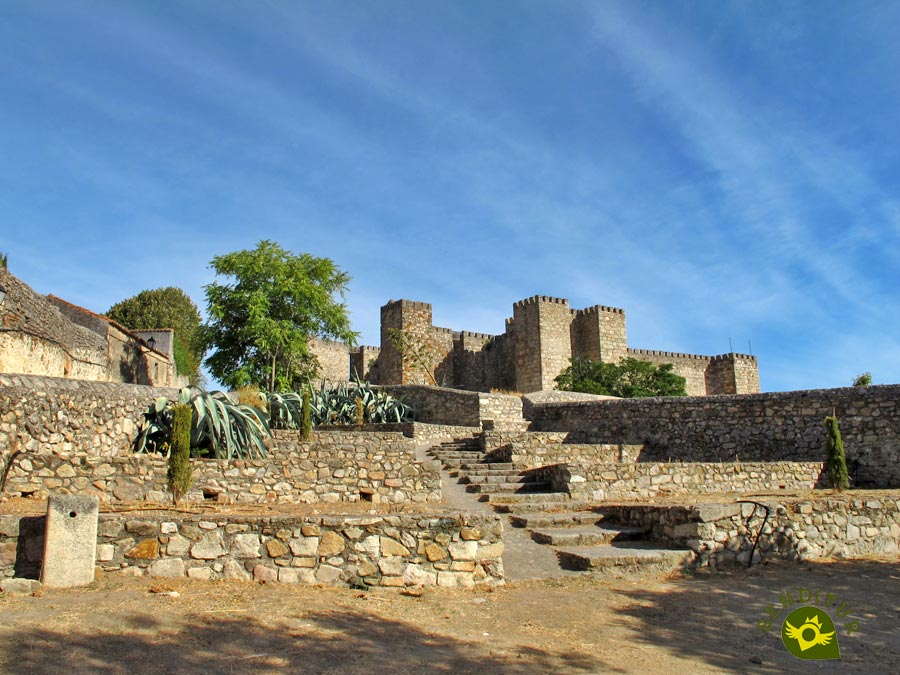Castle of Trujillo
Pedro I I considered her to be one of the safest fortresses in the kingdom
Pedro I I considered her to be one of the safest fortresses in the kingdom
It is located in the highest part of the town, built on a rocky hill called Cabezo de Zorro from where you can control the whole town and the vast plain of Trujillo. The Castle of Trujillo, of Arab origin, was built in the middle of the 9th century and rebuilt in the 13th century after King Alfonso VIII reconquered the area for the Christians. It then became part of the defensive bastions of the crown of Castilla. To the importance of its defensive work we must add relevant facts that happened in it as it served as a refuge for Juana La Beltraneja, in their dispute with Queen Isabel I, until he had to leave to escape to Plasencia, where he married Alfonso V of Portugal, when the castle was granted to the Catholic. In addition, King Fernando the Catholic, on the occasion of his trip to Guadalupe, became interested in the works being undertaken there.

The walled enclosure, which is rectangular in shape with crenellated towers and walls, has its entrance right between the two main towers that guard a gate in a very closed horseshoe arch and just above a glass niche houses the image of the Virgen de la Victoria, patron saint of Trujillo. Once inside, you can visit the two areas that make up the fortress, the Parade Ground and the area called Albacara. The Parade Ground is the oldest area, the Islamic one, it is a square enclosure with prismatic towers, the horseshoe arch door is also part of this period, there are two cisterns and the access to the Virgen de la Victoria chapel. One of the cisterns, with vaulted rooms and barrel arches, has been fitted out with a small bridge over the water for visits. The area called Albacar or Albacara was built during the 13th and 14th centuries. It has a polygonal shape and houses a 16th century hermitage dedicated to San Pablo. It seems that the enclosure had seven doors, of which four are still preserved: the door of the Coria, the so-called Arch of Triumph, the door of San Andrés and the door of Santiago. On the ashlar stones at the base of the walls of the Parade Ground, inscriptions in Latin and Arabic can be seen. Curiously, several films have been filmed in this castle and whether or not the visitor has seen them, when visiting it he can let his imagination run wild in those remote years and feel like a warrior or a brave conqueror because the surroundings invite him to do so.

In the enclosure, the image of Nuestra Señora de la Victoria, patron saint of the city, is venerated. The council of Trujillo agreed back in 1531 that the image of the Virgin should be placed between the two towers of the castle, since according to oral tradition, thanks to the fact that the Virgin appeared with the Child in her arms between two towers of the wall, the citadel was reconquered. The city's coat of arms also reflects this.
The image of the Virgin of the Victory has its back to the small chapel that has been built in the castle to venerate her. Located at the top of the entrance door to the castle, it watches over the Trujillo plain through a large window. But if any devotee leaves any alms, the image, for a time, turns its face towards the chapel and then returns to its usual position.

Legend has it that when King Fernando III the Santo in his struggle to reconquer land from the Moors appeared before the gates of Castle of Trujillo, an Arab sheikh in his hasty flight, hid a golden calf between the banks of the river Almonte, very close to the castle. And it is said that when the Almonte River increases its flow the mythical golden calf drinks directly from its waters.
Castle of Trujillo has opening hours and can be visited every day of the year in the morning and afternoon.
MORE ROUTES AVAILABLE, DON'T MISS IT...
MORE PLACES AVAILABLE, DON'T MISS IT...
You can reach Trujillo from Cáceres by following the A-58 motorway. The A-5 also passes through the town on its stretch between Navalmoral de la Mata and Mérida, and in the same way different local roads link Trujillo to nearby towns. Trujillo has a bus station with regular services that connect it with various cities and capitals, Madrid, Barcelona, Salamanca, Valladolid, Caceres ... and also with nearby towns. The station is located in Campo de San Juan, s/n and the telephone number for further information is 927 321 202.
The Castle of Trujillo is located in the upper part of the town that preserves its medieval layout of narrow streets. The ideal is to park our vehicle and enjoy walking the streets of Trujillo, although we can also access with it to the surroundings of the castle where we can park it and make the visit.
SENDITUR is not responsible for any variation in the information described, as well as for the misuse of its guides and recommends that everyone be responsible and prudent in carrying out the activity. Likewise, we invite you to document yourself with books and specialized guides to complement the information described. From the commitment of SENDITUR with Nature and the respect to the balance of the environment, SENDITUR urges you to travel in a responsible way, with low environmental impact and respecting at all times the Natural, Cultural and Social environment wherever you go. For any suggestion, SENDITUR invites you to send an email to
Continue watching …